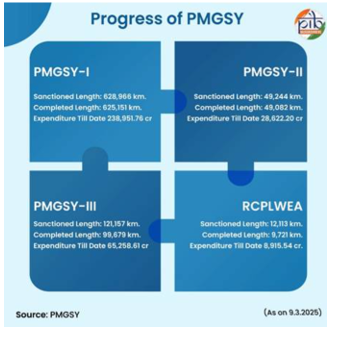

15th September 2025 (15 Topics)
Context
As of August 2025, PMGSY has sanctioned over 1.91 lakh rural roads and 12,146 bridges, strengthening connectivity and socio-economic development in remote areas.
Bridging Rural Isolation Through Infrastructure
Introduction
- PMGSY, launched on 25th December 2000, is a flagship programme aimed at providing all-weather road connectivity to unconnected rural habitations.
- Roads enhance access to markets, healthcare, education, and employment, fostering inclusive socio-economic growth.
- Example: In Madhya Pradesh, the construction of a bridge over Rojhan Nalla enabled 2,000 villagers—mostly SC/ST—to access schools, hospitals, and markets safely, generating nearly 3,000 days of employment during construction.
Objectives of PMGSY
- Ensure all-weather connectivity for unconnected habitations.
- Improve rural livelihoods through better access to markets and services.
- Promote socio-economic development in backward, tribal, and LWE-affected regions.
- Facilitate inclusive development and poverty alleviation in rural India.
Phases and Progress
- PMGSY Phase I (2000)
- Focused on connecting eligible unconnected habitations.
- As on 31 July 2025: 1,63,339 habitations sanctioned; 1,62,818 (99.7%) constructed.
- PMGSY Phase II (2013)
- Upgradation of existing rural roads for economic and transportation efficiency.
- Road Connectivity Project for LWE-Affected Areas (RCPLWEA, 2016)
- Targeted 44 LWE-affected districts in 9 states.
- Objectives: support anti-LWE operations and provide socio-economic upliftment.
- PMGSY Phase III (2019)
- Consolidation of through routes, farm-to-market links, and connections to higher secondary schools, hospitals, and Gramin Agricultural Markets.
- Facilities connected:38 lakh GAs, 1.46 lakh educational centers, 82,000 medical centers, 3.28 lakh transport/other facilities.
- PMGSY Phase IV (2024–29)
- Target: connect 25,000 unconnected habitations.
- Proposed road length: 62,500 km; total outlay: ?70,125 crore.
- Special focus on tribal, desert, and aspirational districts.
Use of Technology and Green Initiatives
- Green Construction Technologies
- Adoption of eco-friendly materials: fly ash, slag, waste plastic, crumb rubber-modified bitumen, bamboo crash barriers, geosynthetics, etc.
- 1,66,694 km sanctioned using green technology; 1,24,688 km completed as of August 2025.
- Digital Monitoring and Maintenance
- OMMAS: real-time monitoring of physical and financial progress, quality checks via Project Management Information System (PMIS).
- e-MARG: performance-based maintenance contracts, ensuring long-term durability.
- GPS Vehicle Tracking System: mandatory for construction machinery since May 2022.
- Three-Tier Quality Monitoring
- Tier 1: Field-level checks by executing agency.
- Tier 2: Independent State Quality Monitors (SQMs).
- Tier 3: Surprise inspections by National Quality Monitors (NQMs).
Integration with Social Development Initiatives
- Dharti Aaba Janjatiya Gram Utkarsh Abhiyan (DA-JGUA):
- Holistic development of tribal communities; PMGSY-IV ensures road connectivity for habitations with high ST population.
- Pradhan Mantri Anusuchit Jaati Abhyuday Yojana (PM-AJAY):
- Targets SC-dominated habitations for socio-economic upliftment and infrastructure access.
- Pradhan Mantri Janjati Adivasi Nyaya Maha Abhiyan (PM-JANMAN):
- Road connectivity component: 6,506 km sanctioned to connect 2,636 habitations of Particularly Vulnerable Tribal Groups (PVTGs).
Impact on Rural Development
- Economic Access: Easier transport of agricultural produce, better market prices, employment generation.
- Social Upliftment: Improved access to healthcare, education, and government schemes.
- Inclusivity: Special focus on SC/ST communities and vulnerable groups.
- Environmental Sustainability: Use of green construction technologies contributes to SDGs, including poverty reduction and climate resilience.
Way Forward
- Enhanced Use of Technology: Integrate AI and GIS for predictive maintenance and traffic management.
- Community Participation: Encourage local employment and skill development during road construction and maintenance.
- Sustainability Focus: Expand the use of renewable and recycled materials in rural roads.
- Monitoring & Evaluation: Strengthen real-time quality checks and periodic post-construction audits to ensure durability and economic benefits.
- Inclusive Planning: Prioritize connectivity for habitations in remote, tribal, LWE-affected, and aspirational regions to achieve equitable growth.
More Articles


